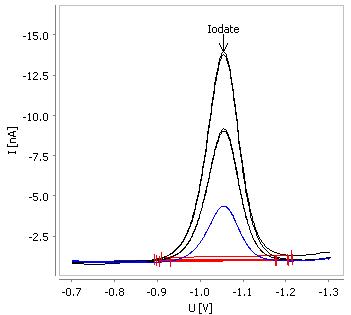Monitoring the iodide concentration in NaCl brine is crucial during membrane process-based chlor-alkali electrolysis. Iodide can easily oxidize to iodate during electrolysis, leading to its precipitation and fouling of the membrane surface. Fouling can reduce the high efficiency of the membrane process and lead to increased energy consumption and decreased product quality. Therefore, monitoring the iodide concentration can help prevent fouling and protect the expensive membranes used in this process.
Stripping voltammetry, with its low detection limit and quick analysis capabilities, emerges as an attractive tool for the analysis of iodide in highly concentrated brines. By utilizing voltammetry, chlor-alkali plants can effectively monitor and manage iodide levels, thus preventing membrane fouling. This approach not only preserves membrane durability and function but also results in high performance of the electrolysis process.
Sodium chloride brine, β(NaCl) = 300 g/L

Add 10 mL oxidized sodium chloride brine sample and 2 mL of ultrapure water into the measuring vessel. The determination of iodide is carried out with the 884 Professional VA (Figure 1) using the parameters specified in Table 1. The concentration is determined by two additions of iodate standard addition solution.
| Parameter | Setting |
|---|---|
| Mode | HMDE |
| Start potential | -0.7 V |
| End potential | -1.3 V |
| Sweep rate | 13 mV/s |
| Peak potential iodide | -1.05 V |
- Multi-Mode Electrode pro

The chlor-alkali brine solution contains a high concentration of chloride ions that can interfere with the direct measurement of iodide. By converting iodide to iodate, these interferences are minimized. The determined iodate concentration is then recalculated as iodide concentration as indicated in Table 2.
The method is suitable for the determination of low concentrations of iodide in sodium chloride brine (β(NaCl) = 300 g/L) samples.
| Sample | Iodate (μg/L) |
|---|---|
| Sodium chloride brine | 72.86 |
| Sample | Iodide (μg/L) |
|---|---|
| Sodium chloride brine | 52.63 |
Internal references: AW VA CH-0628-022024
 Share via email
Share via email
 Download PDF
Download PDF